Development of Photocatalytic Coatings by Thermal Hydrolysis of TiCl4 on Ceramic Roofing Tiles Made from Ferroalumina and Evaluation of De-Pollution Properties
Abstract
:1. Introduction
2. Materials and Methods
2.1. Ceramic Substrates
2.2. Characterization Techniques
2.3. CVD Apparatus and Procedures
2.4. Photocatalytic Degradation Experiments
3. Results and Discussion
3.1. Physico-Chemical Properties of Ceramic Substrates
3.2. Crystalline Phases and Morphology of Coated Surfaces
3.3. TiO2 Synthesis
3.4. Photocatalytic Degradation of Indigo Carmine
3.4.1. Preliminary Tests
3.4.2. Photocatalytic Activity of Coated Ceramics
4. Conclusions
Author Contributions
Funding
Acknowledgments
Conflicts of Interest
References
- Da Silva, A.L.; Dondi, M.; Raimondo, M.; Hotza, D. Photocatalytic ceramic tiles: Challenges and technological solutions. J. Eur. Ceram. Soc. 2018, 38, 1002–1017. [Google Scholar] [CrossRef]
- Ducman, V.; Petrovič, V.; Škapin, S.D. Photo-catalytic efficiency of laboratory made and commercially available ceramic building products. Ceram. Int. 2013, 39, 2981–2987. [Google Scholar] [CrossRef]
- Tobaldi, D.M.; Tucci, A.; Roda, G.C.; Baldi, G.; Esposito, L. Photocatalytic activity for exposed building materials. J. Eur. Ceram. Soc. 2008, 28, 2645–2652. [Google Scholar] [CrossRef]
- Munafò, P.; Goffredo, G.B.; Quagliarini, E. TiO2-based nanocoatings for preserving architectural stone surfaces: An overview. Constr. Build. Mater. 2015, 84, 201–218. [Google Scholar] [CrossRef]
- Balasubramanian, G.; Dionysiou, D.; Suidan, M.; Baudin, I.; Laine, J. Evaluating the activities of immobilized TiO2 powder films for the photocatalytic degradation of organic contaminants in water. Appl. Catal. B: Environ. 2004, 47, 73–84. [Google Scholar] [CrossRef]
- Fujishima, A.; Rao, T.N.; Tryk, D.A. Titanium dioxide photocatalysis. J. Photochem. Photobiol. C Photochem. Rev. 2000, 1, 1–21. [Google Scholar] [CrossRef]
- Hashimoto, K.; Irie, H.; Fujishima, A. TiO2 Photocatalysis: A Historical Overview and Future Prospects. Jpn. J. Appl. Phys. 2005, 44, 8269–8285. [Google Scholar] [CrossRef]
- Zhang, X.; Wang, J.; Dong, X.-X.; Lv, Y.-K. Functionalized metal-organic frameworks for photocatalytic degradation of organic pollutants in environment. Chemosphere 2020, 242, 125144. [Google Scholar] [CrossRef]
- Arsac, F.; Bianchi, D.; Chovelon, J.; Conchon, P.; Ferronato, C.; Lair, A.; Sleiman, M. Photocatalytic degradation of organic pollutants in water and in air. An analytical approach. Mater. Sci. Eng. C 2008, 28, 722–725. [Google Scholar] [CrossRef]
- Herrmann, J.-M.; Duchamp, C.; Karkmaz, M.; Hoai, B.T.; Lachheb, H.; Puzenat, E.; Guillard, C. Environmental green chemistry as defined by photocatalysis. J. Hazard. Mater. 2007, 146, 624–629. [Google Scholar] [CrossRef]
- Moreno, A. Ceramic tiles: above and beyond traditional applications. Bol. Soc. Esp. Ceram. V. 2006, 45, 59–64. [Google Scholar] [CrossRef]
- Yang, H.; Zhang, K.; Shi, R.; Tang, A. Sol-Gel Synthesis and Photocatalytic Activity of CeO2/TiO2 Nanocomposites. J. Am. Ceram. Soc. 2007, 90, 1370–1374. [Google Scholar] [CrossRef]
- Chen, Y.; Stathatos, E.; Dionysiou, D.D. Microstructure characterization and photocatalytic activity of mesoporous TiO2 films with ultrafine anatase nanocrystallites. Surf. Coatings Technol. 2008, 202, 1944–1950. [Google Scholar] [CrossRef]
- Li, G.; Ciston, S.; Saponjic, Z.V.; Chen, L.; Dimitrijevic, N.M.; Rajh, T.; Gray, K.A. Synthesizing mixed-phase TiO2 nanocomposites using a hydrothermal method for photo-oxidation and photoreduction applications. J. Catal. 2008, 253, 105–110. [Google Scholar] [CrossRef]
- Zeatoun, L.; Feke, D. Characterization of TiO2 Smoke Prepared Using Gas-Phase Hydrolysis of TiCl4. Part. Part. Syst. Charact. 2006, 22, 276–281. [Google Scholar] [CrossRef]
- Watanabe, T.; Kojima, E.; Norimoto, K.; Saeki, Y. Fabrication of TiO2 photocatalytic tile and its practical applications. Fourth Euro-Ceramics 11 Floor Wall Tiles 1995, 175–180. [Google Scholar]
- Sun, H.; Wang, C.; Pang, S.; Li, X.; Tao, Y.; Tang, H.; Liu, M. Photocatalytic TiO2 films prepared by chemical vapor deposition at atmosphere pressure. J. Non-Crystalline Solids 2008, 354, 1440–1443. [Google Scholar] [CrossRef]
- Song, G.; Liang, J.; Liu, F.; Peng, T.; Rao, G. Preparation and phase transformation of anatase–rutile crystals in metal doped TiO2/muscovite nanocomposites. Thin Solid Films 2005, 491, 110–116. [Google Scholar] [CrossRef]
- Ding, Z.; Hu, X.; Yue, P.L.; Lu, G.Q.; Greenfield, P.F. Synthesis of anatase TiO2 supported on porous solids by chemical vapor deposition. Catal. Today 2001, 68, 173–182. [Google Scholar] [CrossRef]
- Kim, J.; Hwang, D.W.; Kim, H.G.; Bae, S.W.; Lee, J.S.; Li, W.; Oh, S.H. Highly Efficient Overall Water Splitting Through Optimization of Preparation and Operation Conditions of Layered Perovskite Photocatalysts. Top. Catal. 2005, 35, 295–303. [Google Scholar] [CrossRef]
- Yang, Y.; Sun, Y.; Jiang, Y. Structure and photocatalytic property of perovskite and perovskite-related compounds. Mater. Chem. Phys. 2006, 96, 234–239. [Google Scholar] [CrossRef]
- Minella, M.; Minero, C. Quantification of the Photocatalytic Self-Cleaning Ability of Non-Transparent Materials. Materials 2019, 12, 508. [Google Scholar] [CrossRef] [PubMed] [Green Version]
- CEN European Committee for Standarization. EN 16845-1:2017 Photocatalysis. Anti-Soiling Chemical Activity Using Adsorbed Organics under Solid/Solid Conditions. Part1: Dyes on Porous Surfaces; CEN European Committee for Standarization: Brussels, Belgium, 2017. [Google Scholar]
- Vaiano, V.; Sarno, G.; Sannino, D.; Ciambelli, P. Photocatalytic properties of TiO2-functionalized tiles: influence of ceramic substrate. Res. Chem. Intermed. 2015, 41, 7995–8007. [Google Scholar] [CrossRef]
- Red Mud Project - Site dedicated on the valorisation and best practices on bauxite residue. Available online: http://redmud.org/ (accessed on 15 September 2019).
- Pontikes, Y.; Nikolopoulos, P.; Angelopoulos, G. Thermal behaviour of clay mixtures with bauxite residue for the production of heavy-clay ceramics. J. Eur. Ceram. Soc. 2007, 27, 1645–1649. [Google Scholar] [CrossRef]
- Vautier, M.; Guillard, C.; Herrmann, J.-M. Photocatalytic Degradation of Dyes in Water: Case Study of Indigo and of Indigo Carmine. J. Catal. 2001, 201, 46–59. [Google Scholar] [CrossRef]

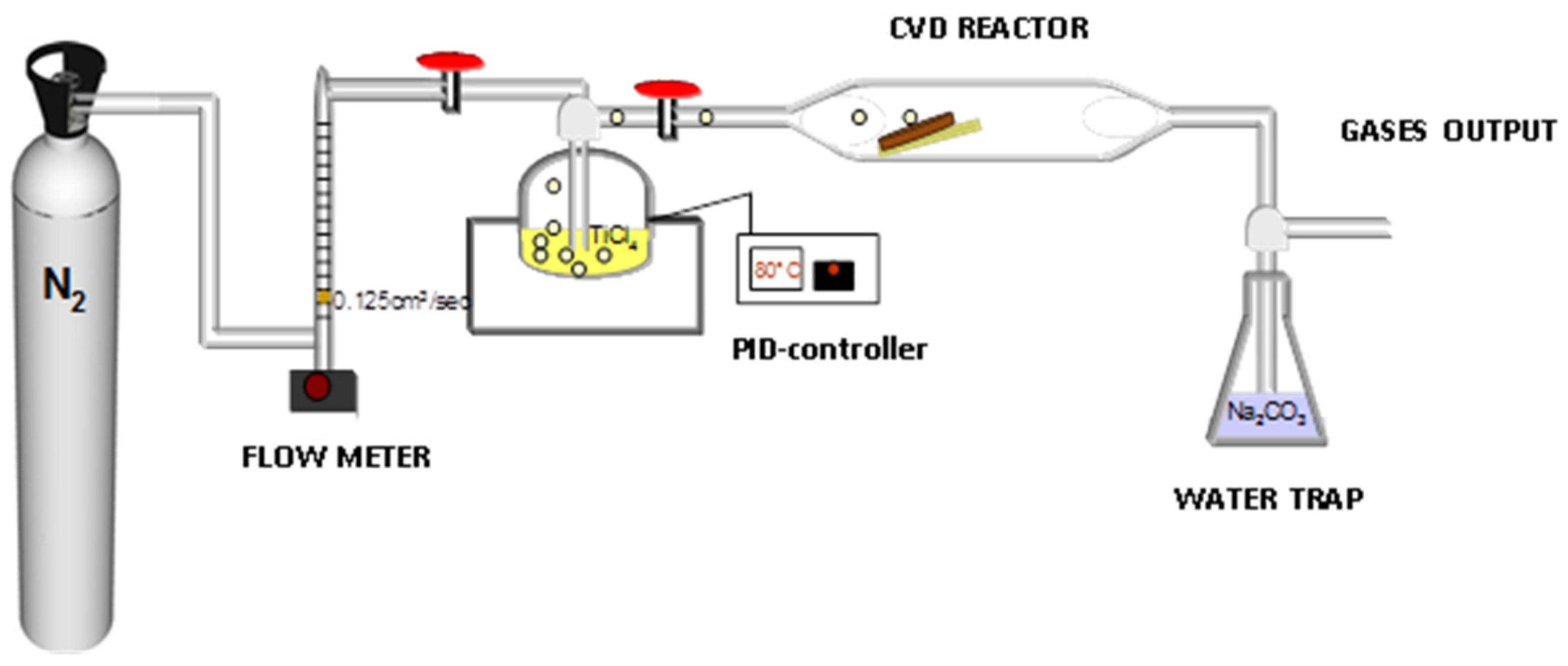
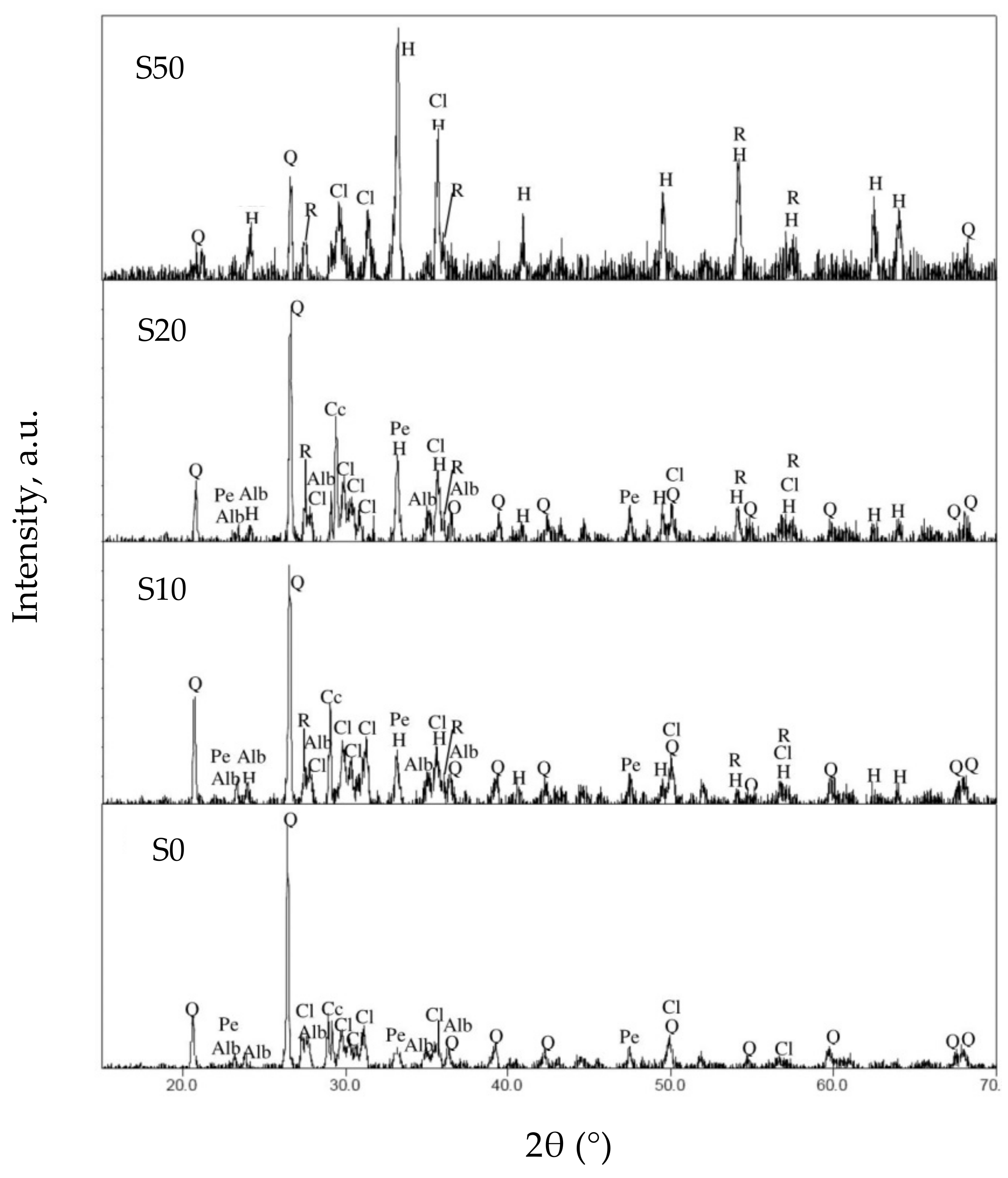
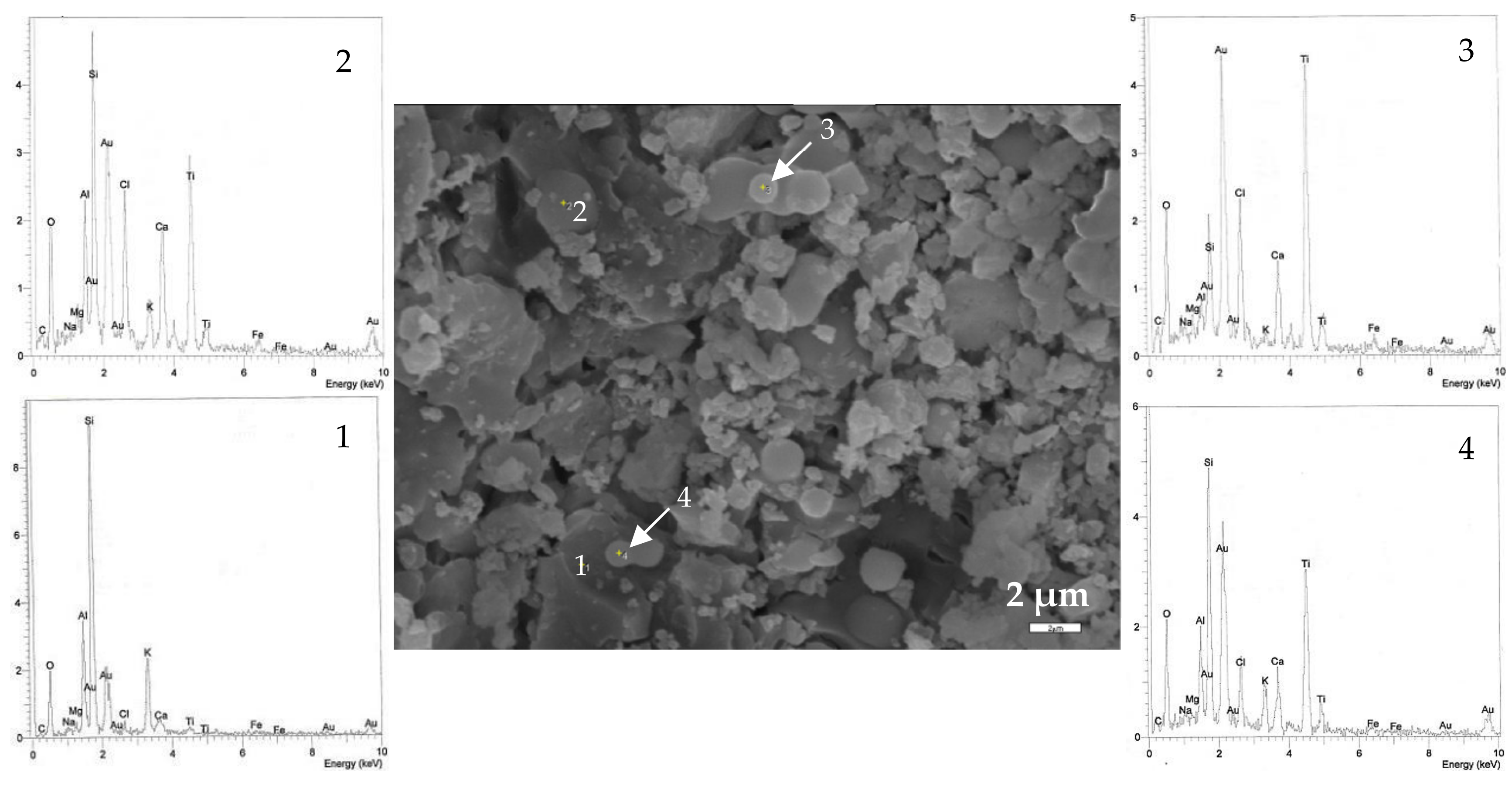

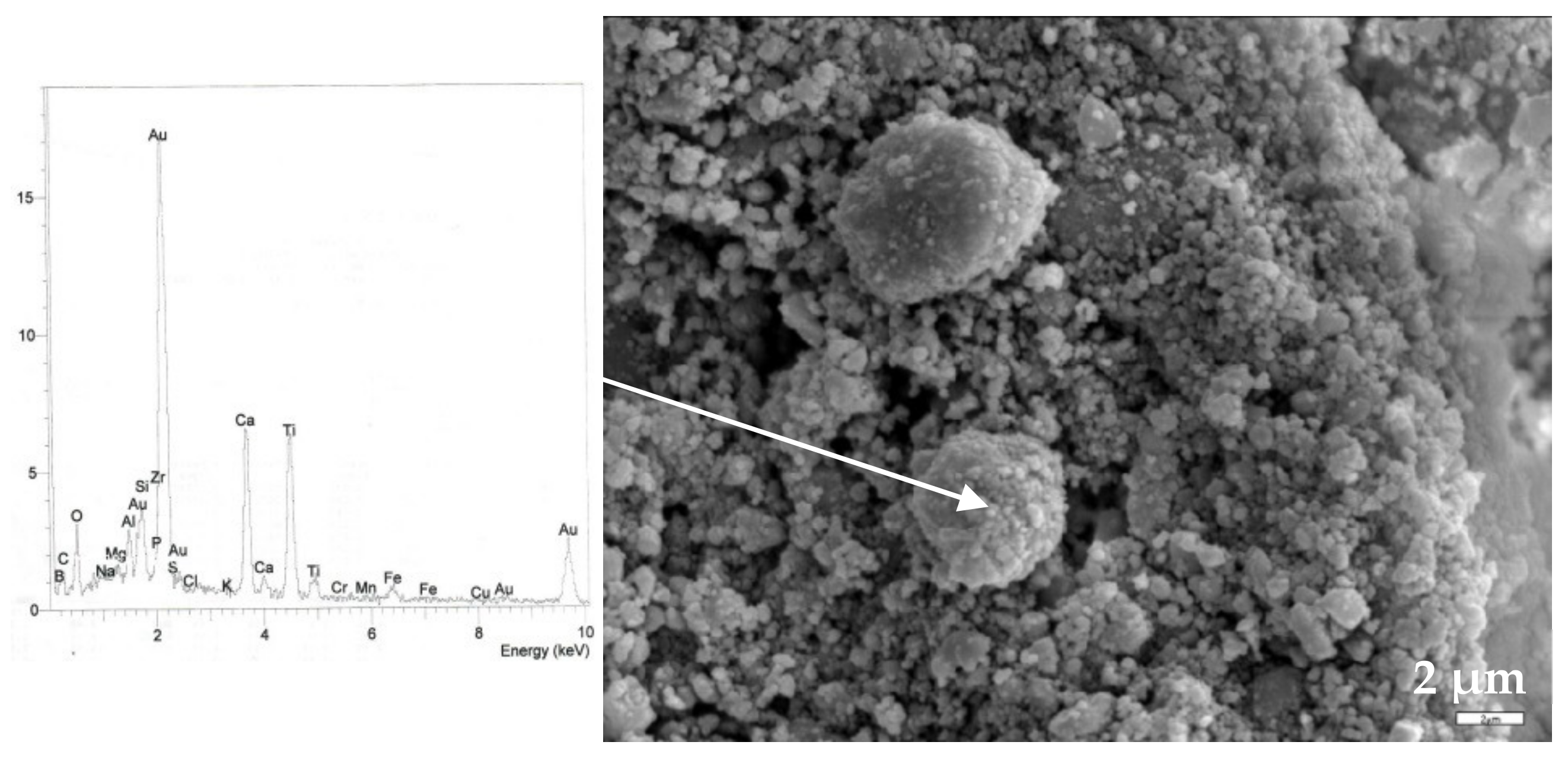
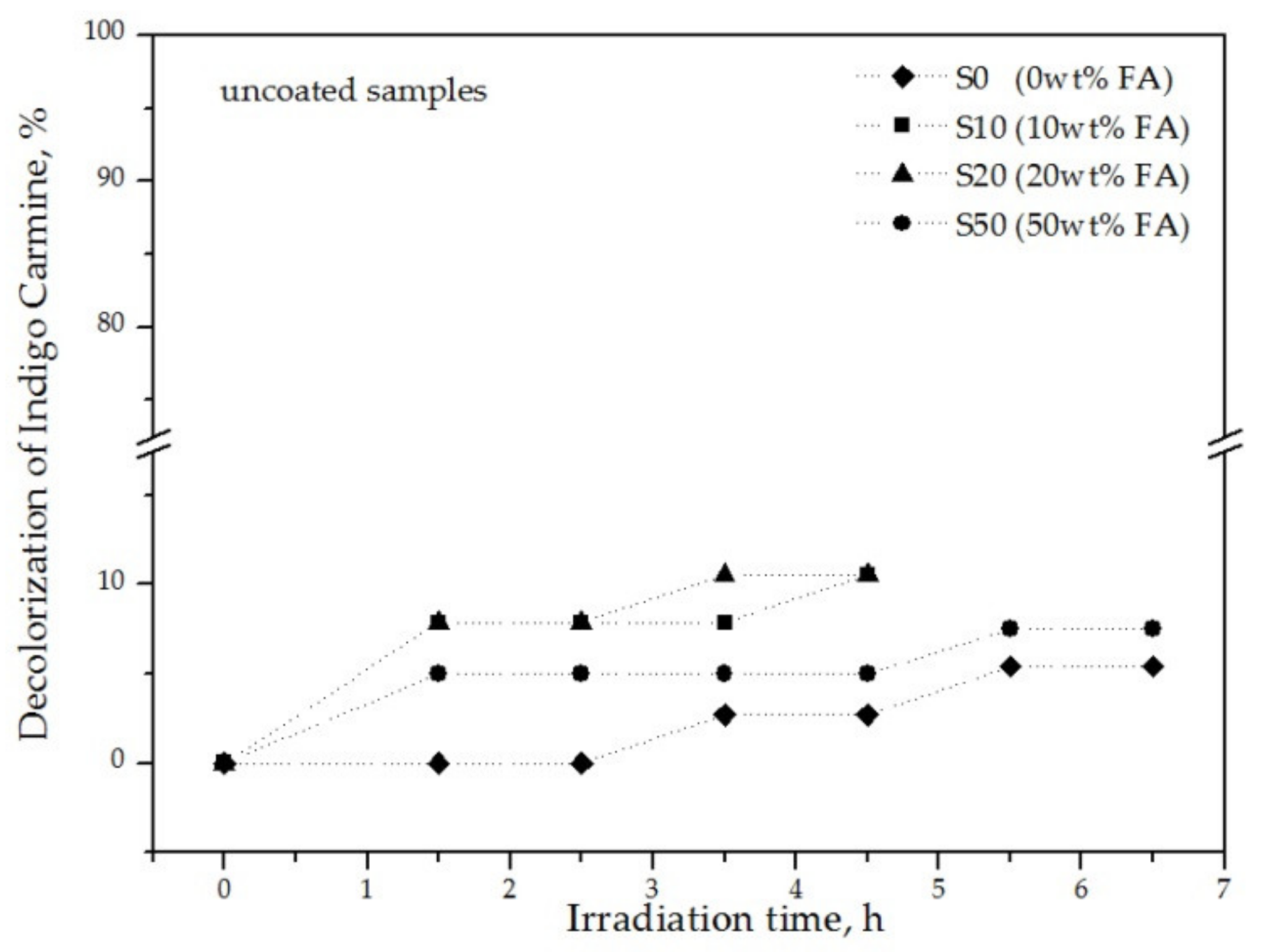

| SiO2 | Al2O3 | CaO | Fe2O3 | MgO | K2O | Na2O | TiO2 | L.O.I. | |
|---|---|---|---|---|---|---|---|---|---|
| W | 48.29 | 13.61 | 12.72 | 5.30 | 3.11 | 2.49 | 0.59 | n.d. | 13.64 |
| FA | 7.79 | 17.04 | 11.64 | 44.34 | 0.57 | 0.07 | 3.17 | 5.12 | 9.77 |
| Quartz | Albite | Calcite | Diopside | Hematite | |
|---|---|---|---|---|---|
| S0 | 27.9 | 17.9 | 14.1 | 40.1 | n.d. |
| S10 | 22.7 | 14.4 | 11.3 | 45.4 | 6.2 |
| S20 | 21.3 | 7.9 | 10.9 | 46.4 | 13.5 |
| S50 | 9.6 | n.d. | 25.5 | 20.6 | 44.2 |
| Quartz | Albite | Calcite | Diopside | Hematite | Rutile | Perovskite | |
|---|---|---|---|---|---|---|---|
| S0 | 22.4 | 18.7 | 15.1 | 38.5 | n.d. | n.d. | 5.2 |
| S10 | 19.3 | 15.1 | 14.1 | 42.1 | 2.2 | 2.2 | 5.1 |
| S20 | 19.0 | 8.7 | 13.1 | 43.6 | 8.2 | 2.1 | 5.3 |
| S50 | 9.0 | n.d. | 26.6 | 19.8 | 38.9 | 5.7 | n.d. |
© 2020 by the authors. Licensee MDPI, Basel, Switzerland. This article is an open access article distributed under the terms and conditions of the Creative Commons Attribution (CC BY) license (http://creativecommons.org/licenses/by/4.0/).
Share and Cite
Christogerou, A.; Koumpouri, D.; Angelopoulos, G.N. Development of Photocatalytic Coatings by Thermal Hydrolysis of TiCl4 on Ceramic Roofing Tiles Made from Ferroalumina and Evaluation of De-Pollution Properties. Materials 2020, 13, 620. https://doi.org/10.3390/ma13030620
Christogerou A, Koumpouri D, Angelopoulos GN. Development of Photocatalytic Coatings by Thermal Hydrolysis of TiCl4 on Ceramic Roofing Tiles Made from Ferroalumina and Evaluation of De-Pollution Properties. Materials. 2020; 13(3):620. https://doi.org/10.3390/ma13030620
Chicago/Turabian StyleChristogerou, Angeliki, Dimitra Koumpouri, and George N. Angelopoulos. 2020. "Development of Photocatalytic Coatings by Thermal Hydrolysis of TiCl4 on Ceramic Roofing Tiles Made from Ferroalumina and Evaluation of De-Pollution Properties" Materials 13, no. 3: 620. https://doi.org/10.3390/ma13030620





